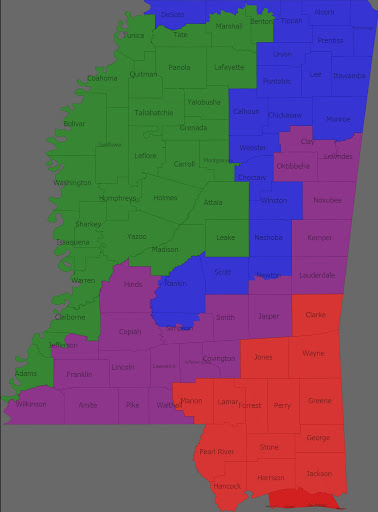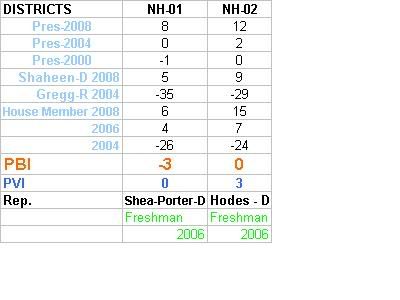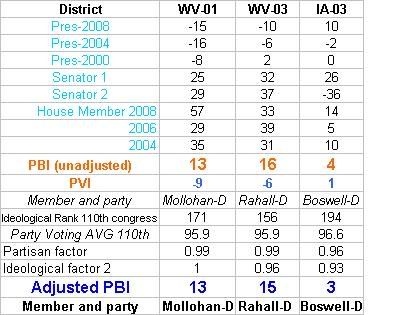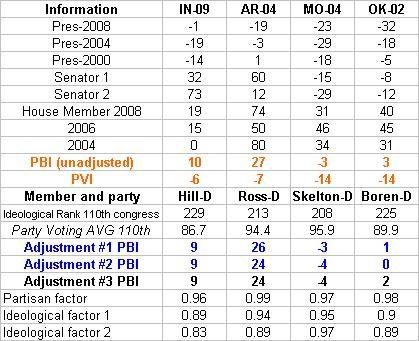When Congressional districts are redistricted after the 2010 Census, it will be possible to redistrict both the States of Alabama and Mississippi so that each has an additional reasonably compact Black majority congressional district. As you can see in the table below, Alabama most definitely has a high enough African American population for 2 of its 7 Congressional districts to be Black opportunity districts. Anything less than that would pretty clearly constitute the dilution of Black voting power in Alabama. Mississippi is a closer case, but between 2000 and the 2010 census, it will have passed the point at which it is more proportional to have 2 African American opportunity districts than to have only 1. It is also less of a sure thing that two African American Representatives could actually be elected, because the Black majorities in the two African American districts cannot be too large.
AL and MS Demographics, 2000 and 2008
State |
Year |
% Black |
% White |
Proportional Majority-Minority Districts |
Total Congressional Districts |
|---|
MS |
2000 |
36.7% |
62.4% |
1.48 |
4 |
|---|
MS |
2008 |
37.2% |
58.7% |
1.55 |
4 |
|---|
AL |
2000 |
26.3% |
70.3% |
1.91 |
7 |
|---|
AL |
2008 |
26.4% |
68.4% |
1.95 |
7 |
|---|
Here is what I came up with for Mississippi:

Redistricted Congressional District Data
District |
Obama |
McCain |
Other |
Total |
Obama % |
McCain % |
White % |
Black % |
|---|
1 |
95078 |
224861 |
3263 |
323202 |
29.42% |
69.57% |
73% |
20% |
|---|
2 |
182986 |
146763 |
2219 |
331968 |
55.12% |
44.21% |
43% |
52% |
|---|
3 |
184268 |
150996 |
2252 |
337516 |
54.60% |
44.74% |
45% |
51% |
|---|
4 |
92330 |
201977 |
2872 |
297179 |
31.07% |
67.96% |
71% |
22% |
|---|
The 2nd and 3rd Districts are Majority Black and should lean Democratic, while the 1st and 4th Districts only have about 20% African American population each and are very, very Republican. I did not have to radically change the general shapes and geographic characteristics of Mississippi’s Congressional districts in order to achieve this. Nor did I have to cross county lines willy-nilly, although with some trading around of territory, it would almost certainly be possible to increase the African American % of either or both the 2nd and 3rd districts by a couple of points.
The Obama/McCain numbers are presumably a pretty good guide of whether or not Black candidates have a shot at getting elected in these districts. Voting was extraordinarily polarized by race – if you can believe the exit polls, Obama got 98% of the Black vote and only 11% of the White vote in Mississippi. In the 2nd and 3rd, the answer is yes – Obama won with about 55% in both. But this is probably not so safe that it is inconceivable that a White/Republican candidate could win under some circumstances, but it should be more difficult for a White or Republican candidate to win these particular 55% Obama seats than most other 55% Obama seats.
It was easy to calculate the vote when counties were not split. In the few cases where they were, I made rough estimates (except for in Jackson, where I maintained the existing CD lines, so that was easy to calculate). So don’t treat those splits as exact numbers, but they won’t be so far enough off that they actually alter the partisanship of the districts as a whole.
MS-1 (Blue)
MS-1 Demographics/2008 Data
District |
Obama |
McCain |
Other |
Total |
Obama % |
McCain % |
White % |
Black % |
|---|
1 |
95078 |
224861 |
3263 |
323202 |
29.42% |
69.57% |
73% |
20% |
|---|
District |
County |
Obama |
McCain |
Others |
Total |
Obama % |
McCain % |
|---|
1 |
Alcorn |
4,130 |
10,805 |
247 |
15,182 |
27.20% |
71.17% |
|---|
1 |
Benton (pt.) |
664 |
449 |
20 |
1,133 |
58.61% |
39.63% |
|---|
1 |
Calhoun |
2,522 |
4,467 |
45 |
7,034 |
35.85% |
63.51% |
|---|
1 |
Choctaw |
1,459 |
2,624 |
45 |
4,128 |
35.34% |
63.57% |
|---|
1 |
DeSoto |
19,627 |
44,222 |
474 |
64,323 |
30.51% |
68.75% |
|---|
1 |
Hinds (pt.) |
6,050 |
9,392 |
122 |
15,564 |
38.87% |
60.34% |
|---|
1 |
Itawamba |
2,084 |
7,663 |
204 |
9,951 |
20.94% |
77.01% |
|---|
1 |
Lee |
12,021 |
22,694 |
245 |
34,960 |
34.39% |
64.91% |
|---|
1 |
Marshall |
2,602 |
3,147 |
39 |
5,788 |
44.96% |
54.37% |
|---|
1 |
Neshoba |
3,114 |
8,209 |
79 |
11,402 |
27.31% |
72.00% |
|---|
1 |
Newton (pt.) |
322 |
3,400 |
22 |
3,744 |
8.60% |
90.81% |
|---|
1 |
Pontotoc |
2,982 |
9,727 |
159 |
12,868 |
23.17% |
75.59% |
|---|
1 |
Prentiss |
3,020 |
7,703 |
221 |
10,944 |
27.60% |
70.39% |
|---|
1 |
Rankin |
14,372 |
48,140 |
591 |
63,103 |
22.78% |
76.29% |
|---|
1 |
Scott |
5,025 |
6,584 |
62 |
11,671 |
43.06% |
56.41% |
|---|
1 |
Simpson (pt.) |
1,512 |
3,808 |
70 |
5,390 |
28.05% |
70.65% |
|---|
1 |
Tippah |
2,623 |
6,937 |
165 |
9,725 |
26.97% |
71.33% |
|---|
1 |
Tishomingo |
1,962 |
6,249 |
208 |
8,419 |
23.30% |
74.22% |
|---|
1 |
Union |
2,985 |
9,072 |
138 |
12,195 |
24.48% |
74.39% |
|---|
1 |
Webster |
1,349 |
4,072 |
36 |
5,457 |
24.72% |
74.62% |
|---|
1 |
Winston |
4,653 |
5,497 |
71 |
10,221 |
45.52% |
53.78% |
|---|
MS-1 drops from 27% Black to 20% Black, as it ditches a few counties with reasonably high Black populations and stretches south to pick up Rankin County, next to Jackson. If Travis Childers can manage to survive in 2010, he would have an even tougher time winning this district in 2012. But 2/3 of his current district remains, so maybe he would have some sort of shot. If he did achieve the impossible, and Gene Taylor stays in Congress, MS could potentially have a 4-0 Dem delegation, at least for a while.
MS-2 (Green)
MS-2 Demographics/2008 Data
District |
Obama |
McCain |
Other |
Total |
Obama % |
McCain % |
White % |
Black % |
|---|
2 |
182986 |
146763 |
2219 |
331968 |
55.12% |
44.21% |
43% |
52% |
|---|
District |
County |
Obama |
McCain |
Others |
Total |
Obama % |
McCain % |
|---|
2 |
Adams |
9,021 |
6,566 |
109 |
15,696 |
57.47% |
41.83% |
|---|
2 |
Amite (pt.) |
632 |
1,481 |
16 |
2,129 |
29.69% |
69.56% |
|---|
2 |
Attala |
3,849 |
5,273 |
61 |
9,183 |
41.91% |
57.42% |
|---|
2 |
Benton (pt.) |
1,563 |
1,880 |
62 |
3,505 |
44.59% |
53.64% |
|---|
2 |
Bolivar |
10,334 |
4,891 |
156 |
15,381 |
67.19% |
31.80% |
|---|
2 |
Carroll |
2,037 |
3,902 |
26 |
5,965 |
34.15% |
65.41% |
|---|
2 |
Claiborne |
4,682 |
748 |
23 |
5,453 |
85.86% |
13.72% |
|---|
2 |
Coahoma |
7,597 |
2,917 |
54 |
10,568 |
71.89% |
27.60% |
|---|
2 |
Franklin |
1,733 |
2,909 |
43 |
4,685 |
36.99% |
62.09% |
|---|
2 |
Grenada |
5,029 |
6,234 |
58 |
11,321 |
44.42% |
55.07% |
|---|
2 |
Holmes |
7,765 |
1,714 |
64 |
9,543 |
81.37% |
17.96% |
|---|
2 |
Humphreys |
3,634 |
1,462 |
30 |
5,126 |
70.89% |
28.52% |
|---|
2 |
Issaquena |
579 |
364 |
7 |
950 |
60.95% |
38.32% |
|---|
2 |
Jefferson |
3,883 |
551 |
44 |
4,478 |
86.71% |
12.30% |
|---|
2 |
Lafayette |
7,997 |
10,278 |
185 |
18,460 |
43.32% |
55.68% |
|---|
2 |
Leake |
4,151 |
5,148 |
60 |
9,359 |
44.35% |
55.01% |
|---|
2 |
Leflore |
8,914 |
4,105 |
62 |
13,081 |
68.14% |
31.38% |
|---|
2 |
Madison |
19,831 |
27,203 |
235 |
47,269 |
41.95% |
57.55% |
|---|
2 |
Marshall |
7,083 |
3,536 |
71 |
10,690 |
66.26% |
33.08% |
|---|
2 |
Montgomery |
2,609 |
3,071 |
32 |
5,712 |
45.68% |
53.76% |
|---|
2 |
Panola |
8,690 |
7,620 |
106 |
16,416 |
52.94% |
46.42% |
|---|
2 |
Quitman |
2,803 |
1,334 |
31 |
4,168 |
67.25% |
32.01% |
|---|
2 |
Sharkey |
1,907 |
873 |
15 |
2,795 |
68.23% |
31.23% |
|---|
2 |
Sunflower |
7,838 |
3,245 |
110 |
11,193 |
70.03% |
28.99% |
|---|
2 |
Tallahatchie |
4,105 |
2,786 |
52 |
6,943 |
59.12% |
40.13% |
|---|
2 |
Tate |
5,003 |
7,678 |
97 |
12,778 |
39.15% |
60.09% |
|---|
2 |
Tunica |
3,279 |
1,017 |
36 |
4,332 |
75.69% |
23.48% |
|---|
2 |
Warren |
10,489 |
11,152 |
123 |
21,764 |
48.19% |
51.24% |
|---|
2 |
Washington |
13,148 |
6,347 |
88 |
19,583 |
67.14% |
32.41% |
|---|
2 |
Wilkinson |
3,534 |
1,560 |
45 |
5,139 |
68.77% |
30.36% |
|---|
2 |
Yalobusha |
3,151 |
3,628 |
47 |
6,826 |
46.16% |
53.15% |
|---|
2 |
Yazoo |
6,116 |
5,290 |
71 |
11,477 |
53.29% |
46.09% |
|---|
MS-2 is Bennie Thompson’s seat, and it remains majority Black, but it drops from 63% African American down to 52%. The main change is that it loses Jackson, which goes to the third district, and it gains population spreading out to the North and the East of its current lines.
This could be a small problem, because Thompson lives in Jackson. A tentacle could be drawn in to Jacskon to take in his home. He could either run in the 3rd district, which will include a substantial amount of new constituents, move to the 2nd. The division of territory between the 2nd and 3rd could also be reconfigured – I would have done that, except it would have looked odd for the 3rd to stretch way up the Mississippi river. One solution might be to use Winston County as a bridge connecting Attala and Noxubee/Oktibbeha/Kemper. Anyone have a good idea of how to do this? Of course, Thompson also just stay where he is and run in the 2nd anyway. Given his longstanding ties to the district, it is not like it would be a major political problem for him not to live in his district.
MS-3 (Purple)
MS-3 Demographics/2008 Data
District |
Obama |
McCain |
Other |
Total |
Obama % |
McCain % |
White % |
Black % |
|---|
3 |
184268 |
150996 |
2252 |
337516 |
54.60% |
44.74% |
45% |
51% |
|---|
District |
County |
Obama |
McCain |
Others |
Total |
Obama % |
McCain % |
|---|
3 |
Amite (pt.) |
2,716 |
2,764 |
41 |
5,521 |
49.19% |
50.06% |
|---|
3 |
Chickasaw |
4,588 |
4,395 |
75 |
9,058 |
50.65% |
48.52% |
|---|
3 |
Clay |
6,558 |
4,466 |
68 |
11,092 |
59.12% |
40.26% |
|---|
3 |
Copiah |
7,710 |
6,701 |
91 |
14,502 |
53.17% |
46.21% |
|---|
3 |
Covington |
3,852 |
5,523 |
86 |
9,461 |
40.71% |
58.38% |
|---|
3 |
Hinds (pt.) |
69,351 |
23,557 |
430 |
93,338 |
74.30% |
25.24% |
|---|
3 |
Jasper (pt.) |
4,724 |
2,848 |
41 |
7,613 |
62.05% |
37.41% |
|---|
3 |
Jefferson Davis |
4,454 |
2,871 |
45 |
7,370 |
60.43% |
38.96% |
|---|
3 |
Kemper |
3,256 |
1,935 |
32 |
5,223 |
62.34% |
37.05% |
|---|
3 |
Lauderdale |
13,332 |
19,582 |
200 |
33,114 |
40.26% |
59.14% |
|---|
3 |
Lawrence |
2,587 |
4,369 |
53 |
7,009 |
36.91% |
62.33% |
|---|
3 |
Lincoln |
5,505 |
10,781 |
116 |
16,402 |
33.56% |
65.73% |
|---|
3 |
Lowndes |
13,209 |
13,994 |
262 |
27,465 |
48.09% |
50.95% |
|---|
3 |
Monroe |
7,169 |
10,184 |
143 |
17,496 |
40.98% |
58.21% |
|---|
3 |
Newton (pt.) |
2,896 |
3,179 |
36 |
6,111 |
47.39% |
52.02% |
|---|
3 |
Noxubee |
5,030 |
1,525 |
34 |
6,589 |
76.34% |
23.14% |
|---|
3 |
Oktibbeha |
9,326 |
9,320 |
146 |
18,792 |
49.63% |
49.60% |
|---|
3 |
Pike |
9,276 |
8,651 |
128 |
18,055 |
51.38% |
47.91% |
|---|
3 |
Simpson (pt.) |
3,305 |
3,833 |
82 |
7,220 |
45.78% |
53.09% |
|---|
3 |
Smith |
1,968 |
6,265 |
72 |
8,305 |
23.70% |
75.44% |
|---|
3 |
Walthall |
3,456 |
4,253 |
71 |
7,780 |
44.42% |
54.67% |
|---|
It turns out that with only relatively minor adjustments, the 3rd District can be given an African American majority. The 3rd district currently stretches from the Southwestern corner of Mississippi up North-East to Starkville. Along the way, it picks up heavily the heavily white Jackson-Suburban Rankin County.
Instead, I now have it picking up Jackson proper, which makes a world of difference. It also extends further northward to pick up areas of Mississippi’s black belt agricultural region around Columbus/West Point. Combined with Jackson, that gives you a high enough African American population to be majority black, even though many counties in between have smaller black populations.
Gregg Harper would most likely be doomed, either against Bennie Thompson or someone else. While it might be possible for a Republican who can appeal to both Black and White voters (is there such a thing in Mississippi???) to win, I have a hard time believing that Gregg Harper is that person. He also no longer lives in the district, because he lives in the ever mentioned Rankin County.
MS-4 (Red)
MS-4 Demographics/2008 Data
District |
Obama |
McCain |
Other |
Total |
Obama % |
McCain % |
White % |
Black % |
|---|
4 |
92330 |
201977 |
2872 |
297179 |
31.07% |
67.96% |
71% |
22% |
|---|
District |
County |
Obama |
McCain |
Others |
Total |
Obama % |
McCain % |
|---|
4 |
Clarke |
3,121 |
5,229 |
47 |
8,397 |
37.17% |
62.27% |
|---|
4 |
Forrest |
11,622 |
15,296 |
266 |
27,184 |
42.75% |
56.27% |
|---|
4 |
George |
1,532 |
7,700 |
103 |
9,335 |
16.41% |
82.49% |
|---|
4 |
Greene |
1,366 |
4,361 |
62 |
5,789 |
23.60% |
75.33% |
|---|
4 |
Hancock |
3,768 |
13,020 |
268 |
17,056 |
22.09% |
76.34% |
|---|
4 |
Harrison |
22,673 |
38,757 |
527 |
61,957 |
36.59% |
62.55% |
|---|
4 |
Jackson |
17,781 |
35,993 |
522 |
54,296 |
32.75% |
66.29% |
|---|
4 |
Jasper (pt.) |
301 |
1,287 |
9 |
1,597 |
18.85% |
80.59% |
|---|
4 |
Jones |
8,846 |
20,157 |
270 |
29,273 |
30.22% |
68.86% |
|---|
4 |
Lamar |
5,159 |
18,497 |
254 |
23,910 |
21.58% |
77.36% |
|---|
4 |
Marion |
4,422 |
8,513 |
75 |
13,010 |
33.99% |
65.43% |
|---|
4 |
Pearl River |
4,320 |
17,881 |
242 |
22,443 |
19.25% |
79.67% |
|---|
4 |
Perry |
1,533 |
4,067 |
64 |
5,664 |
27.07% |
71.80% |
|---|
4 |
Stone |
1,996 |
5,149 |
101 |
7,246 |
27.55% |
71.06% |
|---|
4 |
Wayne |
3,890 |
6,070 |
62 |
10,022 |
38.81% |
60.57% |
|---|
I kept Gene Taylor’s district almost exactly as it is now, because it already has a very small African American population (23%). The only changes are that it gets all rather than part of Jones and Marion counties, and loses its piece of Jasper County. This reduces the Black population 3%, to 20%. This combination of counties meets the population requirements almost exactly.
This doesn’t do anything to affect Gene Taylor at all. He will continue to hold his R+20 district until he decides to retire, at which point a Republican is guaranteed to win it.
MS-4 could also donate some African American voters to the third if it were necessary, with potential tendrils reaching into Hattiesburg and a few other places.
I also made a map for Alabama, but I won’t bother going into detail with that one because Johnny Longtorso has already posted a map that is basically identical to what I had made.
Mine is basically the same, except it does not cross county lines as frequently. The result is a map that looks less gerrymandered, but on the other hand my 7th District is 1% less African American than his, and my 2nd District is 3% less African American than his. That doesn’t really make much difference, as both seats should be pretty safely Democratic regardless, and more Democratic than the two Mississippi seats I drew.





